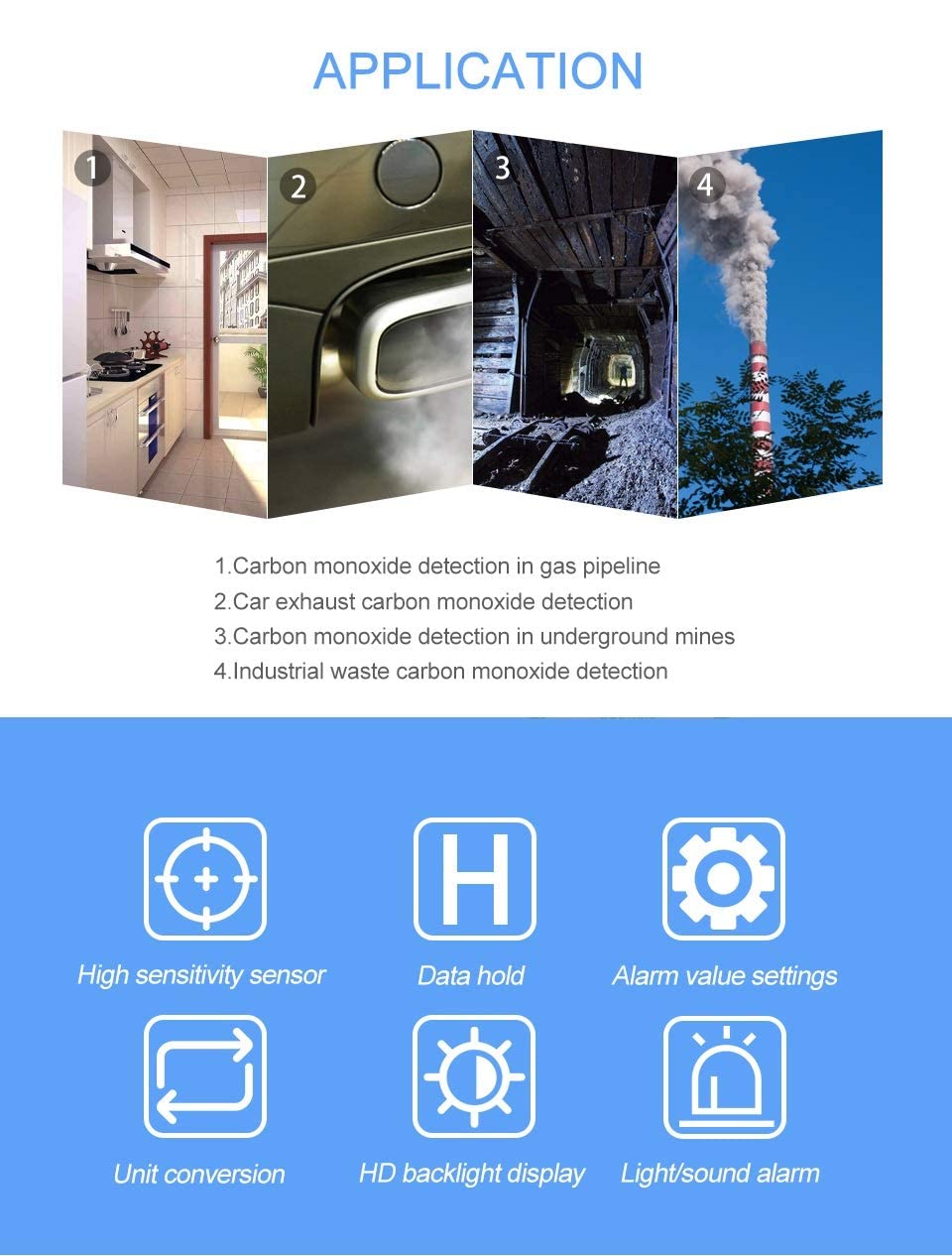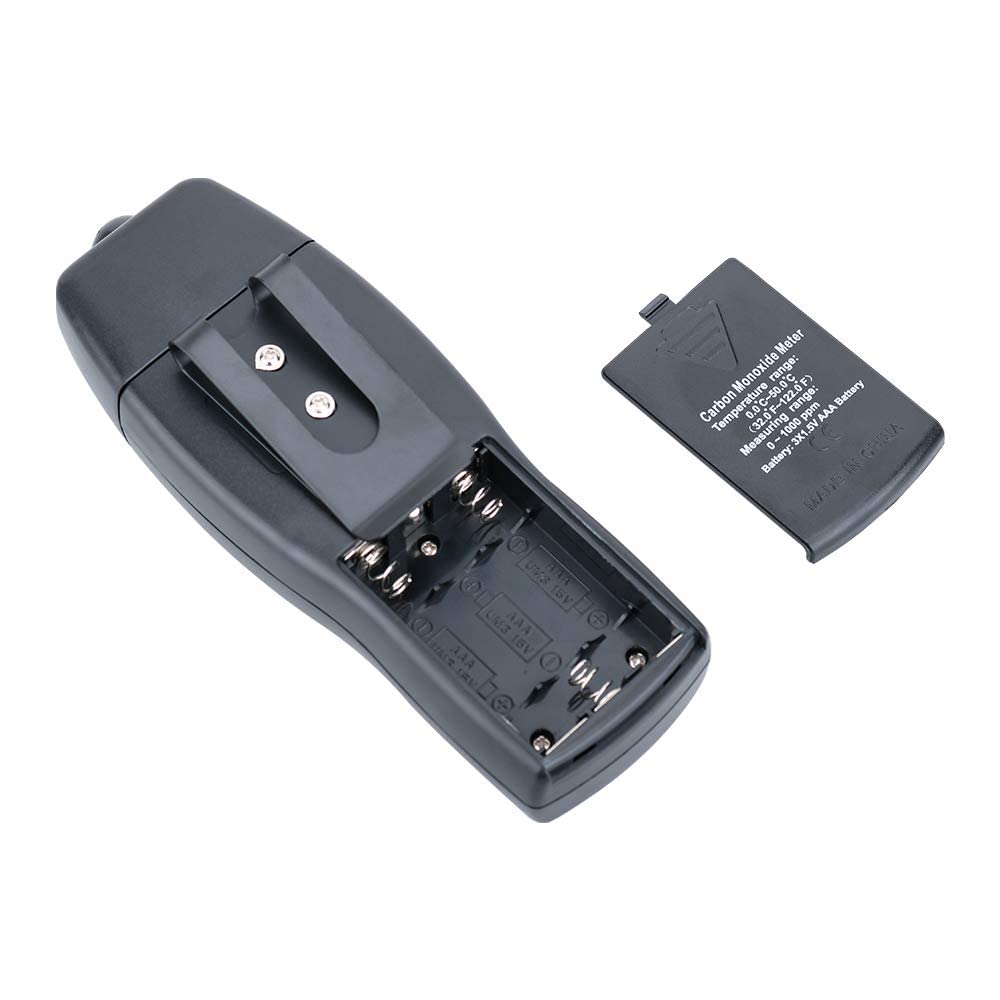معلومات عنا
دعم العملاء
احصل على التطبيق

قم بتوجيه الكاميرا لتنزيل التطبيق
حقوق الطبع والنشر © 2024 Desertcart Holdings Limited









Stay Safe, Stay Smart! 🚨
The Cheffort Handheld Carbon Monoxide Meter is a professional-grade CO gas tester designed for both industrial and home use. It features a wide measuring range of 0-1000 PPM, an LCD backlit display for easy reading in low light, and customizable alarm settings. Compact and lightweight, this device is made from durable ABS plastic, ensuring reliability and precision in detecting carbon monoxide levels.
| Brand | Cheffort |
| Style | Gas Detector |
| Power Source | Battery Powered |
| Colour | Orange + Black |
| Item Weight | 89 Grams |
| Alarm | Audible |
| Operating Humidity | 0-99 percent |
| Upper Temperature Rating | 50 Degrees Celsius |
| Sensor Type | Electrochemical |
| Material | Plastic |
| Number of Items | 1 |
| Manufacturer | Cheffort |
| UPC | 612409905314 |
| Country of Origin | China |
| Product Dimensions | 3.51 x 5 x 13.49 cm; 89 g |
| ASIN | B091DRT5DN |
M**K
A LIFESAVER LITERALLY. EVERY PILOT SHOULD OWN ONE
I am a recreational pilot and have been periodically employing this device to double check cockpit CO levelsRecently I made a familiarisation flight in an aircraft intended for the flight training of my childrenDespite the ‘spot’ type CO detector remaining clear I carried the Cheffort detector during this flight .Immediately following engine start the detector sounded a low level alarmThis persisted throughout a brief test flight during which ventilation and heater controls were manipulated.Subsequently it was found that the heater system had been miss-assembled in the pastEvery previous pilot would have been subjected to some risk of degraded performance from a constant but otherwise undetectable CO leak . Every pilot should own one .
K**.
Works well
This is a very important tool.
K**R
Great spot checker for the money
I purchased this specifically to check my furnace, which was beginning to get pitted in the heater module, which can cause CO leakage. However, for this review, I just used my car's tailpipe to check operation.DESIGN: This is a very ergonomically designed handheld with a nice display and good ease of use, once you decipher the chinese-english manual. It takes three AAA batteries and has a belt clip in the rear. It does have the CE approval mark on the battery cover.RESPONSE TIME: The response time to get an accurate reading is 120 seconds. When you first turn on the unit, it begins a 120-second countdown before it goes to the main screen to let you know when the first valid reading is. This is a nice feature, and it is also nice that you can skip the delay and go straight to the reading by pressing the power button again. I think some of the people who claimed the unit didn't detect CO may have not read the manual.FUNCTIONALITY: It has everything you would need for a CO monitor.-- MODES: You can set it in MAX hold mode, which causes the unit to only update if a reading is higher than the last displayed reading. This is especially useful if you don't want to wait around for an intermittent CO source to turn on. For example, you could set this on the floor next to a gas furnace and go back and check it later. There is a HOLD mode to just keep the current displayed value on-screen, such as if you wanted to record the value in a logbook. When you press the MODE button from SCAN mode, you go to HOLD mode. The MIN mode operates like the MAX mode, although I don't think most users will have any use for it. We all want to know the MAX value, right?-- UNITS: You can read the units as PPM or umol/mol by pressing and holding the C/F button in SCAN mode. Default is PPM.-- AUTO OFF: By default, the unit remains on until you shut it off, but there is also an Auto Off mode that shuts it off after 30 minutes without a keypress. The manual is incorrect about how to change this. You need to press and hold the BACKLIGHT button while in SCAN mode, then press the button again to toggle the mode ON or OFF. Another press and hold gets you back to the main screen. A nice feature is that when it is turned on, a little clock icon will be shown on the display to let you know it is set.- ALARM LIMIT: You can change the limit at which the unit alarms by pressing and holding the MODE button while in SCAN mode. You then use the C/F button to move the cursor to different digits, and the BACKLIGHT button to change the value. You press and hold the MODE button again once the limit is set to return to the main screen. The default is 24 PPM, and you should not change this if you are using this to monitor CO while you are sleeping. Prolonged exposure above this limit is dangerous. I think the main reason to adjust this limit is if you are using the device to obtain readings you know are high, and you don't want the annoyance of an alarm condition. I do think the currently set limit should either always be displayed on the screen, or displayed each time the unit is powered on, since this is a safety setting. It is not, so it is a good idea to always verify the alarm threshold if you are using this for your personal protection.-- ALARM: When the set threshold is exceeded, the device will beep loudly and flash the backlight on and off. I tested this by putting the device near my tailpipe. It responded immediately with a reading above the threshold, and the CO level began to climb due to the sensor's response time. The 2nd photo shows the alarming unit.-- C/F: The unit displays the ambient temperature in degrees Celsius or Farenheit. You can toggle between units by pressing the C/F button from any displayed mode in the main screen.-- CO UNITS: You can display the CO units in PPM or umol/mol simply by pressing and holding the C/F button. Each press and hold toggles the unit display. This is not mentioned in the manual.-- BACKLIGHT: The BACKLIGHT button ( a bulb icon) turns the green backlight on and off.MANUAL: Poorly written by Chinese author who doesn't know English well. Sadly, this occurs all too often with products made in China. There is some missing information, and some outright incorrect information in the description of how to use the product. I am deducting one star strictly because of the user manual, and I think it is important to have a well-written user manual, especially for a safety device. See above for the correct way to perform the various functions.SERVICE LIFE: The manual states that the sensor is only good for three years. Be aware of this when you purchase it. If used infrequently, you may want to test it with a CO emission before relying on it for safety purposes.---- RATINGS (5 is best) ---DESIGN: *****FUNCTIONALITY: *****CO DETECTION: *****ALARM: *****MANUAL: ***OVERALL RATING: ****Country of Manufacture: Chine
B**Y
Import household device
Everybody should have some type of CO {carbon monoxide} detector. I bought this unit to check for CO that might exist in my house and shop. I really wanted to know if their were any PPM {part per million} detected. It is very easy to use. I wish it would default to degrees F instead of degrees C. It has a Alarm / buzzer if the CO is at 100ppm or more. This unit works as stated - I tested it while using kerosene heaters in the shop. I compare it to other CO detectors my 3 friends have and all readings were the same value, so I know it works. One important note, If this CO detector gets drop hard, I would replace it than chance it.
S**R
Who Can You Trust.
I consider this instrument a "second opinion." I can not attest to any type of accuracy or reliability. There was a problem with certain model years of SUVs drawing in exhaust from the air pressure created behind and below the body of the car while moving. Some experts thought it was not adequately addressed by the automobile manufacturer. The manufacturer said they did everything necessary. Who is right. I bought one of these, and kept it with me a few times while driving. It did not detect elevated carbon monoxide. Not sure that proves anything, but if the detector had shown an excessive level of carbon monoxide, then I would have a reason to take the car in for repairs. Now I just use it any time I am using a non-vented heater. I recall the light planes I once flew, had simple CO detector cards in them. If it turned dark brown, you had a carbon monoxide problem. Not sure if those are still made, but they were simple and reliable.
ترست بايلوت
منذ 3 أسابيع
منذ 3 أسابيع